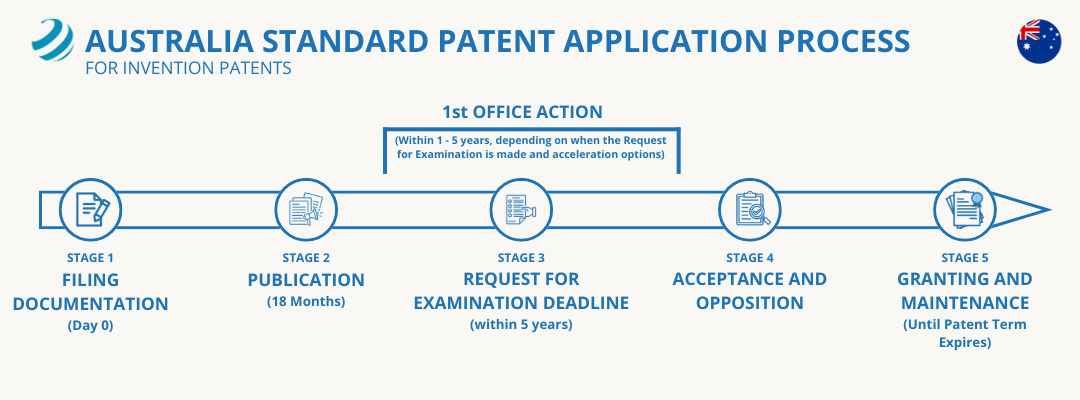Patent Filing in Australia: A Comprehensive Guide to the Australian Patent Process
Australia’s patent system has unique features. This comprehensive guide demystifies how to file a patent in Australia and highlights what sets the Australia patent filing process apart from other countries. We will cover the types of patents available, the routes for filing a patent in Australia, key requirements and documentation, the timeline from application to grant, and strategic tips for applicants looking to protect their innovation in this jurisdiction.
By focusing on Australia’s patent application procedures, this article will help you apply for a patent in Australia with an understanding of local requirements and particularities.

Why It Is Important to File a Patent in Australia
Filing a patent in Australia is a strategic decision for inventors and businesses looking to protect and commercialize their innovations in a stable, innovation-driven market. Australia offers a transparent and efficient intellectual property system, administered by IP Australia, that provides strong legal protection and international alignment with major patent frameworks.
A granted Australia patent not only prevents others from making, using, or selling your invention within the country but also strengthens your competitive position in one of the most advanced economies in the Asia-Pacific region.
In addition, the Australian patent filing process is known for its flexibility and efficiency, including options like the Patent Prosecution Highway (PPH) and expedited examination, which can help applicants secure protection faster.
Overview of Patent Types in Australia
Australia offers a few distinct types of patent filings, each serving different needs:
1. Standard Patent
The Standard Patent is the primary type of Patent in Australia. This kind of patent undergoes full examination and provides long-term protection up to 20 years from filing, or 25 years for eligible pharmaceutical inventions (QLD GOV AU). Standard patents require an invention to be novel and involve an inventive step over existing knowledge, providing robust protection once granted.
In contrast, Australia historically also had an Innovation Patent, a second-tier patent intended for incremental or short-term innovations. Innovation patents were quick and inexpensive, had a lower inventive threshold (“innovative step”), and lasted a maximum of 8 years (IP Australia). However, this type has been phased out, and no new innovation patents have been accepted since August 25th, 2021 (existing innovation patents filed on or before that date remain in force until their 8-year term expires).
2. Provisional Application
A provisional application is essentially a placeholder filing that secures a priority date for your invention at minimal cost (IP Australia). It is not examined or granted as a patent, and it holds your filing date for 12 months, during which you can decide whether to proceed with a full patent application or not (IP Australia).
The provisional is never published or enforceable by itself. If you don’t file a corresponding complete application (standard or PCT) within 12 months, the provisional lapses in secret.
The benefit of a provisional is that it gives you time to refine the invention, conduct market research, or seek investors while locking in an early date (effective for priority in Australia and internationally). After 12 months, you must convert the provisional into a standard patent application (often called a complete application) or an international application to maintain that priority date.
3. Industrial Design
An industrial design is a distinct IP right separate from standard patents, focused on a product’s appearance rather than its technical function. A registered design in Australia lasts for up to 10 years in total. Initial registration provides 5 years of protection, and a one-time renewal can extend it for another 5 years (reaching the maximum 10-year term)
Key Insight
Australia’s patent system includes Standard Patents for long-term protection for a 20-year term. Provisional Applications are a useful first step to secure an early filing date, however they don’t themselves become patents but preserve your priority while you prepare a full application. Australia also offers Industrial Design registrations for up to 10 years of protection.
Australia Standard Patent Process Timeline
The patent process in Australia follows a structured sequence managed by IP Australia. Understanding these timeframes helps applicants plan strategically and maintain protection throughout prosecution. The Standard Patent Process should be as it follows:

Patent Filing Routes in Australia: Direct Filing vs PCT National Phase
Australia allows two main pathways for patent filing a direct national application, which can be preceded by an optional provisional application, or entry via the international Patent Cooperation Treaty (PCT) route.
1. Direct National Filing or Paris Route
You can file a patent application in Australia directly with IP Australia as either your first filing or claiming priority from a prior application in another country. If you have filed an application elsewhere in a Paris Convention member country, you generally have 12 months from the earliest priority date to file a corresponding Australian application claiming that priority (IP Australia). This is often called the Paris Convention route. For example, if you filed in the US or EU first, you must file in Australia within 12 months to claim that foreign priority.
Direct filing is straightforward for applicants who know from the outset that they want protection in Australia. Australian law does allow extensions of the 12- month convention deadline in very limited circumstances (e.g. unintentional error or circumstances beyond control), but one should not rely on this and should plan to meet the standard deadline.
2. PCT National Phase Entry
The alternative route is to use an international PCT application. If you file under the PCT (Patent Cooperation Treaty), that single international application can be used to seek patents in many countries. Australia is a PCT member, and the deadline to enter the national phase in Australia is 31 months from the earliest priority date of the PCT application (WIPO). This gives you a bit more time, compared to the 12-month direct route, to decide if you want an Australian patent, which can be helpful for evaluating the invention’s commercial potential.
Please note, it is not required to wait the full 31 months as early national phase entry is permitted in Australia. In fact, you can enter as soon as you’re ready, even immediately after the PCT application is filed. If you enter the Australian national phase before the PCT’s international publication, you simply need to provide IP Australia with a copy of the PCT application (since it wouldn’t yet be publicly available) and any amendments, plus an English translation if the PCT was not in English (WIPO). Once you enter early, the application will be treated like any other Australian application and will proceed on normal timelines unless you request expedited processing.
It’s worth noting that whether you file via the direct route or the PCT route, the substantive outcome is an Australian standard patent application examined under Australian law. The choice of route mainly affects timing and initial procedure. Direct filing is often chosen by Australian residents or when Australia is the first filing country, sometimes beginning with a provisional. The PCT route is common for foreign applicants who include Australia among their designated countries, as it defers the cost and decision of entering Australia up to 31 months.

Key Insight
Applicants have two pathways to patent registration in Australia: (1) file directly with IP Australia, with a 12-month window to claim any foreign priority, or (2) enter via a PCT international application (within 31 months from the earliest priority date. The PCT route offers more time and flexibility for global filings, while direct filing may be faster if Australia is a primary target. Both routes ultimately result in an Australian patent application that will follow the local examination and grant process.
Patent Filing Process in Australia
When preparing to apply for a patent in Australia, it’s crucial to understand the patent filing process as a whole. Understanding the timeline, from filing, to publication, examination, and finally grant, is crucial for managing expectations. The Australian process has some unique timing aspects, such as a deferred examination system and a pre-grant opposition period, that differ from other jurisdictions.

Who Can Apply
A patent application in Australia can be made by the inventor(s) or by a person or company who has derived rights from the inventor. In practice, this means the inventor, an assignee, such as an employer or a company to whom the inventor has assigned the invention, or the inventor’s legal representative can be the applicant (IP Australia).
Notably, if the applicant is not a resident of Australia or New Zealand, an Australian (or NZ) address for service must be provided for correspondence (IP Australia). This typically means foreign applicants should appoint an Australian patent attorney or agent to handle the filing, though the law does not require the agent to be an attorney as long as an address in Australia/NZ is given.
In summary, any entity (individual or corporate) can file, but foreign parties will need a local address for service of documents in the proceedings.

Required Documents
The documentation required to file is straightforward. You need to submit a complete specification document describing the invention in detail and defining the claims (legal scope of protection). This document must be in English, as Australia does not allow filing in another language and later providing a translation, so a translation must be ready at filing if the original was in another language. The specification should include a title, description of the invention, with any drawings necessary to understand it, at least one claim defining the invention, and an abstract for publication.
Along with the specifications document, you must provide certain forms containing information such as inventor names, applicant details, etc.
Please note you do not need to submit a power of attorney or inventor oath/declaration when filing in Australia, these formal documents are generally not required for Australian filings. Likewise, if you are claiming priority from a foreign application, you do not have to file a certified copy of the priority document at the time of filing as IP Australia will only request it later in rare cases where verification is needed. This light-touch formality approach can be a relief for applicants
used to jurisdictions with extensive initial paperwork.

Publication
After you file a standard patent application or enter national phase, the application will be kept confidential for a period of time. In Australia, as in most countries, a patent application is typically published 18 months from its earliest priority date. This means about 1.5 years after your initial filing or earlier priority date, if it claims one, IP Australia will publish the application details in the public domain. Publication is officially noted by advertising the application in the Australian Official Journal of Patents (AOJP) and making it available in the Australian patent search database (IP Australia).
If you file via the PCT route, and your international application was already published by WIPO at 18 months, then effectively the world already saw it, but IP Australia will still announce its Australian-specific entry.

Request for Examination
A critical peculiarity of the Australian system is that examination must be requested, and it does not start automatically. An application will not be examined substantively until someone, usually the applicant, files a request for examination and pays the exam fee. The applicant has up to 5 years from the filing date to request examination (IP Australia). If no request is filed by then, IP Australia will issue a direction to request exam, giving a 2-month ultimatum. Failing to request exam in time will cause the application to lapse.
In practice, many applicants choose to request examination well before the 5-year deadline, especially if they want the patent granted sooner. You can even request examination at filing or any time shortly thereafter to get the process moving. Once examination is requested, the application is placed in the examination queue for an examiner to review.

Examination
The wait time for examination can vary depending on the technology field and workload at IP Australia. On average, it is around 9–12 months from the request to get a first examination report.
If you’re in a hurry, Australia offers options to expedite examination (see below in our section Strategies and Recommendations for Patent Filing in Australia). An expedited examination can shorten the wait to as little as 8 weeks for a first action, provided you give a suitable reason or use the global Patent Prosecution Highway.
During substantive examination, an Australian patent examiner will review the application for compliance with all requirements: proper subject matter, clarity and support of claims, novelty and inventive step over prior art, etc. The examiner then issues an examination report (also known as office action) detailing any objections. The applicant then has the opportunity to respond, amend the claims, and argue their case. Australian law provides up to 12 months to respond to an examiner’s report (IP Australia), and multiple rounds of exchange can happen if needed.
In Australia, any subsequent examination reports issued during the same examination process will generally retain the same response deadline, unless an extension of time is formally requested and granted by IP Australia. For example, if IP Australia issues a first examination report setting a response deadline of December 1st, 2024, and later issues a second report after reviewing your amendments, the same December 1st, 2024, deadline will usually continue to apply.
We therefore strongly recommend providing your instructions, comments, and proposed claim amendments as early as possible to ensure there is sufficient time to prepare and submit a comprehensive response within the prescribed deadline.
Please note that the deadline to respond and overcome all outstanding objections raised in an Australian Examination Report is fixed by IP Australia. Failure to file a timely and complete response will result in the Australian patent application lapsing.

Acceptance, Publication, and Opposition
When the examiner is satisfied that the application meets all requirements, the application is accepted. “Acceptance” in Australia is analogous to “allowance” in the US, it means the patent is set to be granted, but with an additional step: publication of acceptance for opposition.
Upon acceptance, IP Australia will advertise the accepted application in the AOJP and again publish it in the public patent database for a 3-month opposition period (IP Australia). During these 3 months, any interested party, typically competitors) may file a notice of opposition to challenge the patent before it is granted. This pre-grant opposition is a feature of Australian law that allows third parties to submit evidence and argue that the patent should not be granted. If an opposition is filed, proceedings before the Patent Office, and possibly hearings, will take place to resolve it, which can delay grant. If no opposition is filed in the 3-month window, which is the usual scenario for most applications, or if an opposition is filed but ultimately unsuccessful, the application proceeds to grant.

Grant and Term of the Patent
Once the opposition period passes with no opposition, or an opposition is resolved in favor of the applicant, the patent is formally granted. IP Australia will issue a Certificate of Patent and update the registry to show the patent in force (IP Australia). The grant date will be the date the patent is officially sealed/granted, and the patent term is calculated 20 years from the effective filing date.
For standard patents, the maximum term is 20 years from filing. Note that annual renewal fees are payable to keep a granted patent in force. In Australia renewals fall due each year starting from the 4th anniversary of the filing date. If renewals aren’t paid, the patent will lapse.
Once granted, the patentee has the exclusive rights to exploit the invention and can enforce the patent against infringers.
It’s also important to mention timeline expectations. The overall time from filing to grant can vary widely. If an applicant files and immediately requests examination, and there are no major hiccups, a patent might grant in as short as 1–2 years. If an applicant waits the full 5 years to request exam, obviously it will take much longer.
On average, many Australian patents take about 2–4 years from filing to grant, depending on the chosen pace. IP Australia notes that the process takes at least 6 months even in the fastest cases and can take several years in typical scenarios.
The Patentarea team observes that standard applications generally take 1 to 3 years to be issued in Australia under normal processing, though options like expedited examination or the PPH can speed this up significantly.
Key Insight
Filing a patent in Australia is accessible and straightforward. Inventors or their assignees can apply, and the required documents are mainly the patent specification and basic forms. The Australian patent process has an 18-month publication, an optional deferred examination (up to 5 years) which gives applicants flexibility, and a unique pre-grant opposition period (3 months after acceptance). This means the fastest path to grant can be well under 2 years with acceleration, while a slow-track case could drag on for 5+ years. Once accepted, if no opposition arises, the patent grant is straightforward, yielding up to 20 years of protection from the filing date.
Strategies and Recommendations for Patent Filing in Australia
Developing the right filing strategy can significantly impact the success and value of your Australian patent.
Beyond the basic process, consider these strategies that savvy inventors and IP attorneys often employ in
Australia.
1. Leverage Provisional Applications for Flexibility
As discussed, a provisional application can be a strategic first step. Filing a provisional in Australia before your standard application locks in a priority date and lets you label your invention “patent pending” without committing to the full cost of a complete application immediately. Inventors should use the 12-month provisional period wisely to refine the invention, assess commercial interest, seek partners or funding, and perhaps file additional provisionals if new improvements arise. Before that 12-month deadline, you will need to file a standard patent application to preserve your priority.
The benefit in Australia is that the provisional itself isn’t disclosed if you decide not to proceed, so if the project is abandoned, you haven’t published your idea. If you do proceed, ensure your complete application is filed in time and covers any developments since the provisional. Many Australian applicants file locally as a provisional first, to buy time and prepare a high-quality complete specification and then file a PCT or direct standard application at the 12-month mark claiming that priority.
2. Choose the Right Route and Timing: Direct vs PCT Entry
If you are certain you only need protection in Australia, and possibly a few specific countries, a direct filing under the Paris Convention might save time and administrative complexity. However, if you are pursuing patents in multiple countries or want to keep your options open, use the PCT route and take advantage of the 31-month window for national phase entry into Australia. This allows you to defer Australian filing costs and decision until you have the results of the international search report and perhaps a better sense of the invention’s prospects.
Many applicants will file a PCT application at 12 months, often claiming priority from a provisional or initial country filing, and then wait the full 31 months before deciding on Australian national phase.
If Australia is a key market and you want protection sooner, you could enter the national phase early, even right after the PCT is filed, to get the process started in Australia while the PCT is still ongoing. This might be useful if you have an infringer in Australia or you want an early granted patent there for licensing. Keep in mind that early entry means you’ll incur costs sooner and the 18-month publication will also occur earlier for that national phase.
3. Fast-Track Options: Expedited Examination and PPH
If obtaining a granted patent quickly is important, Australia offers accelerated examination pathways.
One route is simply to request expedited examination directly with IP Australia by providing a suitable reason. Acceptable reasons can include impending commercialization, potential infringement, or special circumstances like the invention being in a field of public interest (e.g. green technology) or the applicant being an SME. There is no additional official fee for an expedite request, just a written request explaining the reason. If IP Australia accepts it, your application jumps the queue, often getting examined within 8 weeks (IP Australia).
Another powerful option is the Global Patent Prosecution Highway (GPPH). Australia is a participating office in the GPPH program. This means if you have a corresponding application in another GPPH country, such as the US, Europe, Japan, Korea, etc., that has at least one claim allowed, you can request PPH accelerated examination in Australia. To use this, the Australian claims should sufficiently correspond to those allowed elsewhere, and you submit a request citing the other office’s work. IP Australia will then fast track your examination, leveraging the foreign examination results. The GPPH is a popular route for those who first secure a patent in one jurisdiction and then want to speed up others.
4. Managing Examination Timing
Because Australia gives a long 5-year period to request examination, applicants have strategic control over when examination, and associated costs, begin. If you’re not in a rush, you might delay requesting exam to keep the application in pending status while you focus resources elsewhere or await outcomes in other jurisdictions. Just diarize the 5-year deadline so it isn’t missed.
On the flip side, if you want to use your Australian patent early, you should request exam as soon as possible. Remember that no enforcement is possible until grant and grant in Australia can be accelerated to under a year if truly needed (via expedited exam) or can take many years if you let it sit.
In summary, tailor your strategy to your needs. Use provisionals for early priority and breathing room, choose the filing route that matches your international plans, and don’t overlook the tools Australia provides to expedite or manage timing.
Key Insight
Successful Australian patent filings often come down to smart timing and use of the system’s flexibility. Provisional applications give you a low-cost head start and time to evaluate your invention’s potential. The PCT route can strategically delay Australian filing up to 31 months, useful for global patent planning. And when speed is of the essence, Australia’s fast-track options, like expedited examination on request or the Patent Prosecution Highway, can accelerate grant dramatically. In short, adapt your approach to match your business goals: delay steps to conserve resources when appropriate, or accelerate to obtain enforceable rights when time is critical.
Strengthen Your Global IP Strategy with an Australian Patent
Including an Australian patent filing in your international portfolio is a smart way to reinforce your global intellectual property strategy. Australia’s patent system is internationally harmonized, PCT-compatible, and recognized for its transparent and reliable examination standards. This makes it a valuable jurisdiction for protecting innovations that have potential markets in the Asia-Pacific region and beyond.
Filing a patent application in Australia also supports broader business objectives, whether it’s securing investor confidence, enhancing licensing opportunities, or establishing early protection in a growing economy. For global applicants, the ability to enter the PCT national phase in Australia within 31 months of the priority date provides both flexibility and strategic advantage.

Get your Patent Filed in Australia
Contact us today for a free consultation
References
- IP Australia. Timeframes and Fees. Available here. (Reviewed on October 2025)
- IP Australia. How to Apply for a Standard Patent. Available here. (Reviewed on October 2025)
- IP Australia. Provisional Patent Applications. Available here. (Reviewed on October 2025)
- Queensland Government Australia. Types of Patents. Available here. (Reviewed on October 2025)
- World Intellectual Property Organization (WIPO). PCT Applicant’s Guide: Australia. Available here. (Reviewed on October 2025)



